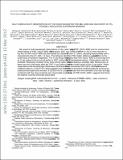Multi-Wavelength Observations of the Radio Magnetar Psr J1622-4950 and Discovery of Its Possibly Associated Supernova Remnant
Author(s)
Chakrabarty, Deepto
DownloadChakrabarty_Multi-wavelength.pdf (305.5Kb)
OPEN_ACCESS_POLICY
Open Access Policy
Creative Commons Attribution-Noncommercial-Share Alike
Terms of use
Metadata
Show full item recordAbstract
We present multi-wavelength observations of the radio magnetar PSR J1622-4950 and its environment. Observations of PSR J1622-4950 with Chandra (in 2007 and 2009) and XMM (in 2011) show that the X-ray flux of PSR J1622-4950 has decreased by a factor of ~50 over 3.7 years, decaying exponentially with a characteristic time of τ = 360 ± 11 days. This behavior identifies PSR J1622-4950 as a possible addition to the small class of transient magnetars. The X-ray decay likely indicates that PSR J1622-4950 is recovering from an X-ray outburst that occurred earlier in 2007, before the 2007 Chandra observations. Observations with the Australia Telescope Compact Array show strong radio variability, including a possible radio flaring event at least one and a half years after the 2007 X-ray outburst that may be a direct result of this X-ray event. Radio observations with the Molonglo Observatory Synthesis Telescope reveal that PSR J1622-4950 is 8' southeast of a diffuse radio arc, G333.9+0.0, which appears non-thermal in nature and which could possibly be a previously undiscovered supernova remnant (SNR). If G333.9+0.0 is an SNR then the estimates of its size and age, combined with the close proximity and reasonable implied velocity of PSR J1622-4950, suggest that these two objects could be physically associated.
Date issued
2012-05Department
Massachusetts Institute of Technology. Department of Physics; MIT Kavli Institute for Astrophysics and Space ResearchJournal
Astrophysical Journal
Publisher
IOP Publishing
Citation
Anderson, Gemma E. et al. “MULTI-WAVELENGTH OBSERVATIONS OF THE RADIO MAGNETAR PSR J1622–4950 AND DISCOVERY OF ITS POSSIBLY ASSOCIATED SUPERNOVA REMNANT.” The Astrophysical Journal 751.1 (2012): 53.
Version: Author's final manuscript
ISSN
0004-637X
1538-4357